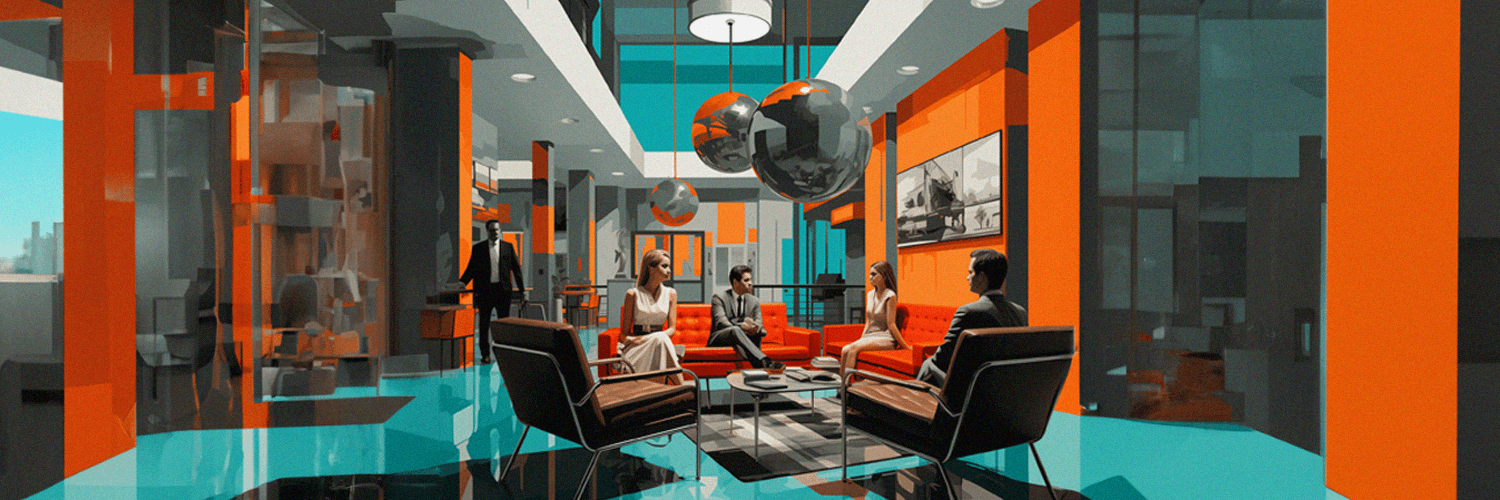Technology is everywhere in our daily lives. Pandemics transformed collaboration apps and video conferencing tools into our new normality. Rotating from email to other communication platforms made businesses realize that the user experience (UX) involved in each piece of software might actually be more important than the technology itself.
Technological novelties are introduced constantly with the promise to make our lives easier. But do they really?
UX for Workplace Technology - Why Is It Important?
Employees crave a smooth, efficient, and interconnected workplace experience comparable to other daily occurrences they are accustomed to, such as being a well-served customer. If one can order lunch and schedule a doctor’s appointment in a few clicks, he should also be able to rapidly book an office desk and plan work status in advance. Therefore, you need to focus on your employee user experience now as much as you do on your customer experience. If your employees can’t use the tech or the apps and programs you’re providing them with you’ll likely see a huge lag in productivity. In other words, if it’s too hard to use, it’s worthless.
Oftentimes, employees are speaking about UX through lost productivity, constant user retraining, or refusal to work with certain programs because they’re just too complicated. Turns out that it's time for your C-suite, HR, and FM managers to listen to them and understand their preferences for building delightful employee experiences within the workplace. Why is it important to ensure a smooth employee experience with your workplace technology?
It Increases Employee Productivity
Any time your employees are using programs that are not intuitive or simple to use, they will either need to be trained constantly on how to run them, or worse they will just give up on using them. They will start losing trust in their capacities of understanding and using technology, and might soon even quit their job. On the flip side, programs that are easy to use will make your employees' lives easier, freeing them up to do bigger, better things.
It Encourages a Culture of Collaboration
Your direct stakeholders like the IT, HR, or the finance department will need to collaborate closely to ensure that the programs selected and funded are the ones that meet the company’s business objectives and respond to your employees’ everyday needs.

It Grows Employee Engagement and User Retention
People would rather work for a company using the latest artificial intelligence (AI), augmented reality (AR), or video conferencing technology in the workplace, instead of a company that uses a fax machine to communicate. Employees are drawn to companies with the latest technology, that simplify their work, keeps them connected and creative.
It Helps Decrease the App Sprawl
App sprawl usually occurs when your software is too hard to use and employees start looking for workarounds to help them complete their tasks faster and easier. That leads to any number of programs downloaded from any number of locations, creating security risks, and wasting IT’s time in added maintenance. On the other hand, when you focus on quality UX from the start, you have fewer apps to manage, and more time to work effectively. Your employees' experience is flawless and their efficiency increases.
It Saves Money
Your entire C-suite level needs to understand the importance of user experience efforts! When software is easy to use, it requires less training and less downtime on the part of employees trying to engineer their way through the meanders of technology. Thus, the return on investment is quicker and better.
Implementing New Technology in the Workplace - What to Take Into Account
When implementing new technology in the workplace, there are some things you should consider, such as:
- Defining your workplace personas to better understand employee needs and user journeys.
- Prioritizing simplicity for users through tools that integrate seamlessly with popular platforms like Microsoft Teams, Slack, Trello, Asana, and others.
- Evaluating the right security layers and engaging with security experts to help perform due diligence from the start. Since the workplace of the future allows any employee to do anything they could do in the office, no matter where they are, you must realize the number of endpoints you need to secure.
- Employees are now using tablets and mobile phones that should have the same amount of security as a laptop. If not, you risk data breach and security complications, something you might not come back from easily.
- Considering noise-cancellation technology that can block out background noise and improve concentration.
- Evaluating augmented reality (AR) and virtual reality (VR) tools for immersive remote customer experiences, employee onboarding and training, etc.

According to Forbes, in terms of UX with workplace technology, Maslow's hierarchy of needs looks a bit different. The basis is represented by the physical needs layer, followed by the social requirements and finally the emotional demands. If all of them are satisfied, employees become more efficient and tech-enthusiast.
Addressing Your Employees’ Physical Needs
To satisfy your employees' physical needs, you must make sure they are well connected to the workplace, whether in the office, remotely or in a hybrid model. Employees who are going into the office full-time know who will be there. But in a hybrid environment, there are some drawbacks that need to be addressed like for example knowing when it's the right time to go into the workplace. Companies can use technology to show employees who will be in the office and who will be working from home, allowing employees to choose when to go in and book a desk to get the most collaborative work accomplished.
When it comes to physical safety in the workplace in the post-pandemics workplace, offices should include comprehensive screenings for Covid-19 symptoms and contact tracing in the event of a positive case. But it's not just about Covid-19. Different types of technology can be used to help facilitate feedback and real-time maintenance requests, reinforce office protocols and put employees at ease when they know everyone working in the same place is healthy.
Addressing Your Employees’ Social Needs
When technology is used to connect employees with office events or building amenities, social needs are being taken care of. For your hybrid workforce, you can create a more connected experience with everything from an online sign-in to accessing Wi-Fi from everywhere, so that people can work where and how they please. What matters here is making employees feel connected and looked after no matter where they are.
Addressing Your Employees’ Emotional Needs
Finally, responding to their emotional needs implies not only creating a more collaborative, well-designed workplace that your employees want to work in, but also delivering a frictionless and fluid work experience through the implementation of efficient technologies.
Examples of Technology in the Workplace
The level of expectations employees have of the technology they use for work should mirror those they are using on a daily basis. They should be able to communicate, do their jobs, and engage in broader work processes through the use of intuitive interfaces and smooth UX with innovation, at work.

Here are some examples of technology in the workplace that will improve your employees' well-being and enable a smooth and efficient user experience:
Smart Office Technologies
Smart office technologies will help you manage workplace user experience such as: desk and room booking, visitor management, or a work planning tool will make your workplace interconnected, catering to all your employees’ needs, no matter the location. Your employees will be able to easily book meeting rooms, desks, and even parking spaces to ensure a safe workplace environment. AI and IoT software will simplify communication between employees in remote workplaces, giving them access to vital projects and data.
Collaboration Tools and Communication Platforms
These are the myriad types of software and online services which companies and their employees can use to track progress on common projects, independent of physical location. Team collaboration tools include cloud storage, document synchronization and file-sharing and storing tools, instant messaging, video conferencing and online whiteboards. Some examples of well-known apps are Zoom, Slack, Microsoft Teams, Asana, to name a few.
Cloud-Based Management Systems
Cybersecurity has become a top priority for organizations in recent years. The threat of hackers compromising your customers’ personal information, or interrupting your workflow has led many businesses to pour more resources into digital security solutions. Many organizations have relied on VPNs, but some security experts believe these leave organizations rather vulnerable. In response, many companies are looking at alternative remote access methods, such as zero-trust network access. The wireless and wired network must manage and secure many different types of devices which can be mobile and must be supported in a seamless manner, so people have a consistently positive experience while security and other corporate policies are enforced.
A recent report from neurological research company Emotiv revealed that good technology can improve worker productivity by a factor of up to 40 per cent. The same research showed that there is a strong causal link between employee productivity and a positive UX with workplace technology. The poorer and less user-friendly the technology is, the bigger the challenge for employers to retain their employees. The same could be said about the office experience.
Manage Your Workplace Effortlessly
A well-managed workplace eliminates small hassles and inconveniences. When visitors arrive, they sign on to get connected to the Wi-Fi, and the next time, they are connected automatically. People book conference rooms using a mobile app, eliminating those persistent complaints about the meeting rooms always being busy. Indoor location services help people find their way across campus and even find other people. High-value assets can be tracked and found quickly.
Space optimization is vital, so a space management software is a necessary requirement of modern workplaces, not a “nice to have”. According to a PwC report, 87% of surveyed executives expect to make changes to their real estate strategy so they are taking up the opportunity to get creative with the workspace over the next couple of years. The goal is to make visits to the office an experience that enhances relationships and the company culture. Actions are likely to include improvements to office decor and an increase in collaborative hubs, including even bringing back some private offices or quiet spaces, as employees need or prefer having a place to go to work as well as a place where they can build relationships.

YAROOMS office capacity management tools help you boost your workplace’s UX by designing activity-based spaces, promoting social interaction, and enhancing the sense of belonging. Solutions such as hot desking allow your employees flexibility and promote social interaction between them. Above all, this reservation system is cost and space-efficient. Having multiple employees sharing one workstation helps company owners cut down costs on expensive office leases.
You also need workplace optimization capabilities based on data analytics. For example, office utilization metrics such as capacity, real-time occupancy, average density, etc. can easily disclose how well workspaces “perform” in comparison to each other. While the office will still serve a variety of professional purposes, it will ultimately become a hotbed for collaboration, innovation, and team bonding as employees look to recreate what they are missing remotely. Companies will turn to workplace analytics and space management tools to clearly understand how space is being used and how to best maximize that space for the team’s current needs.
Collaborate Seamlessly
Enhancing user experience in the workspace doesn't only rely on the space optimization, or workplace analytics, but it also means enforcing virtual collaboration tools.
Here are some of the most popular components for enhanced collaboration:
- Video conferencing
- Instant message (IM)/chat
- Project collaboration
- File sharing
- Shared calendars
- Cloud-based document collaboration
- Online training
- Secure IP sharing
- Project management
- Real-time inventory
- Shared whiteboards
Putting the user at the heart of the workplace technology elevates the working experience and helps your organization achieve more innovation, productivity and cultural engagement. Otherwise, tech built for tech's sake falls flat!
Consider Your Team First Before Adopting a Digital Tool
It's key to remember that technology designed and built with human beings at the center is what makes everyone’s lives easier. Considering your employees' needs before adopting a new technology creates a workplace that encourages collaboration and direct feed-back. You need to work closely from the project outset, all the way to completion, roll-out, and ongoing operation, to ensure that a great user experience is supported by great technology. End users should be intimately involved at all stages as well; without their buy-in, the most theoretically ideal approach can fail.
Before planning to implement a new digital tool, it is important to identify and measure what is going on first. To achieve that, you need to measure the metrics that have a direct impact on the success of your work through direct feed-back and comparative analysis. Feed-back is a straightforward way to identify areas of improvements. At the end of the day, employees are at the heart of the digital workplace which makes their opinion all the more important. Quantitative research surveys can be conducted to rate the level of engagement and satisfaction. The questions can be included in the homepage of the digital workplace with questions like “How much are you satisfied with the digital workplace overall/ or specific feature?” and “How would you feel if we introduced a specific feature to the digital workplace?”. Once the new tool is implemented, you must conduct a comparative analysis helping you measure the performance of a digital workplace before and after UX improvements.
A great digital workplace combines great space design and great technology, with user experience at the core. But what does this feel like in real life, from the user's point of view? It's all about user experiences and making these experiences as seamless, efficient, and fulfilling as possible. All in all, a good UX within the workplace is becoming the norm, triggering the C-suite engagement desired by employees, as well as a growing motivation and efficiency.

.png)









